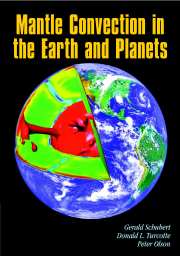Book contents
- Frontmatter
- Contents
- Preface
- 1 Historical Background
- 2 Plate Tectonics
- 3 Structure and Composition of the Mantle
- 4 Mantle Temperatures and Thermodynamic Properties
- 5 Viscosity of the Mantle
- 6 Basic Equations
- 7 Linear Stability
- 8 Approximate Solutions
- 9 Calculations of Convection in Two Dimensions
- 10 Numerical Models of Three-dimensional Convection
- 11 Hot Spots and Mantle Plumes
- 12 Chemical Geodynamics
- 13 Thermal History of the Earth
- 14 Convection in the Interiors of Solid Planets and Moons
- 15 Nature of Convection in the Mantle
- References
- Appendix: Table of Variables
- Author Index
- Subject Index
3 - Structure and Composition of the Mantle
Published online by Cambridge University Press: 15 December 2009
- Frontmatter
- Contents
- Preface
- 1 Historical Background
- 2 Plate Tectonics
- 3 Structure and Composition of the Mantle
- 4 Mantle Temperatures and Thermodynamic Properties
- 5 Viscosity of the Mantle
- 6 Basic Equations
- 7 Linear Stability
- 8 Approximate Solutions
- 9 Calculations of Convection in Two Dimensions
- 10 Numerical Models of Three-dimensional Convection
- 11 Hot Spots and Mantle Plumes
- 12 Chemical Geodynamics
- 13 Thermal History of the Earth
- 14 Convection in the Interiors of Solid Planets and Moons
- 15 Nature of Convection in the Mantle
- References
- Appendix: Table of Variables
- Author Index
- Subject Index
Summary
Introduction
In this chapter we review what is currently known about the structure and the bulk composition of the mantle, with emphasis on how these may influence the style of convection, and how they may be influenced by it. Brief descriptions of the crust and the core are also included, again with an emphasis on those aspects of each region most germane to mantle convection. There are several monographs dealing with Earth structure and composition in a general context, e.g., Ringwood (1975, 1979) and Anderson (1989).
The study of mantle structure is by tradition the province of seismology, while mantle composition has historically been a subject for high-pressure and high-temperature mineralogy, petrology, and geochemistry. A great many important advances have recently been made in these areas, with the result that the studies of mantle composition, structure, and dynamics are now closely related. New findings from seismology, mineral physics, and isotope geochemistry are quickly applied as constraints on models of mantle dynamics. There are also interactions in the other direction. Each new step in understanding the physics of convection is quickly incorporated into new interpretations of mantle structure. This interdisciplinary style of research is perhaps the single most important reason for the emerging view of the deep Earth as a unified physical and chemical system.
Spherically Averaged Earth Structure
The determination of elastic parameters and density throughout the Earth using observations of seismic waves and other constraints is the prototype inverse problem in geophysics. Like many inverse problems, it is formally nonunique and suffers from practical difficulties such as incomplete sampling and errors in the data.
- Type
- Chapter
- Information
- Mantle Convection in the Earth and Planets , pp. 63 - 117Publisher: Cambridge University PressPrint publication year: 2001



